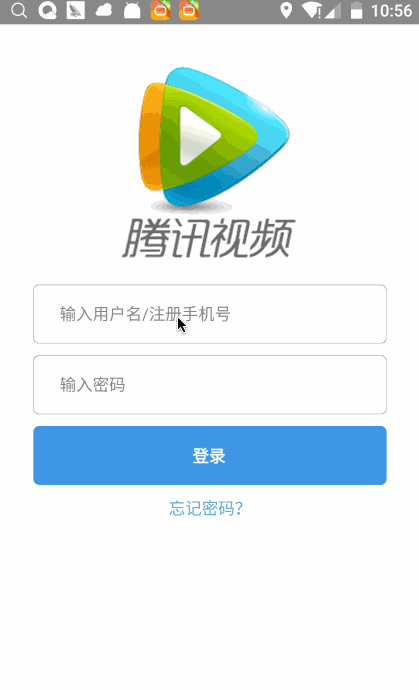react native实现登录功能,包括ui的封装、网络请求的封装、导航器的实现、点击事件。
demo下载:react-native 完整实现登录功能
后台如果是springmvc实现的需要配置上如下代码
<!--加入multipart 的解析器,这个必须配置,一会在controller里抓取上传文件时要用。否则会报错。-->
<bean id="multipartResolver" class="org.springframework.web.multipart.commons.CommonsMultipartResolver">
<property name="maxUploadSize" value="102400"></property>
<property name="defaultEncoding" value="utf-8"/><!--属性:编码-->
</bean>1.实现的界面
2.完整目录
3.主界面的代码实现
import React, { Component } from 'react';
import {
ToolbarAndroid,
AppRegistry,
StyleSheet,
Text,
View,
Image,
TextInput,
TouchableOpacity
} from 'react-native';
import EditView from '../lib/EditView';
import LoginButton from '../lib/LoginButton';
import LoginSuccess from '../ui/LoginSuccess';
import NetUitl from '../lib/NetUtil';
export default class LoginActivity extends Component {
constructor(props) {
super(props);
this.userName = "";
this.password = "";
}
render() {
return (
<View style={LoginStyles.loginview}>
<View style={{flexDirection: 'row',height:100,marginTop:1,
justifyContent: 'center',
alignItems: 'flex-start',}}>
<Image source={require('../image/login.png')}/>
</View>
<View style={{marginTop:80}}>
<EditView name='输入用户名/注册手机号' onChangeText={(text) => {
this.userName = text;
}}/>
<EditView name='输入密码' onChangeText={(text) => {
this.password = text;
}}/>
<LoginButton name='登录' onPressCallback={this.onPressCallback}/>
<Text style={{color:"#4A90E2",textAlign:'center',marginTop:10}} >忘记密码?</Text>
</View>
</View>
)
}
onPressCallback = () => {
let formData = new FormData();
formData.append("loginName",this.userName);
formData.append("pwd",this.password);
let url = "http://localhost:8080/loginApp";
NetUitl.postJson(url,formData,(responseText) => {
alert(responseText);
this.onLoginSuccess();
})
};
//跳转到第二个页面去
onLoginSuccess(){
const { navigator } = this.props;
if (navigator) {
navigator.push({
name : 'LoginSuccess',
component : LoginSuccess,
});
}
}
}
class loginLineView extends Component {
render() {
return (
<Text >
没有帐号
</Text>
);
}
}
const LoginStyles = StyleSheet.create({
loginview: {
flex: 1,
padding: 30,
backgroundColor: '#ffffff',
},
});
说明:
1.使用了线性布局,从上往下依次Image,EditView,LoginButton,Text
2.EditView和LoginButton 为自定义控件,实现输入框,和按钮的封装。
4.EditView.js
import React, { Component } from 'react';
import {
ToolbarAndroid,
AppRegistry,
StyleSheet,
Text,
View,
Image,
TextInput,
TouchableOpacity
} from 'react-native';
export default class EditView extends Component {
constructor(props) {
super(props);
this.state = {text: ''};
}
render() {
return (
<View style={LoginStyles.TextInputView}>
<TextInput style={LoginStyles.TextInput}
placeholder={this.props.name}
onChangeText={
(text) => {
this.setState({text});
this.props.onChangeText(text);
}
}
/>
</View>
);
}
}
const LoginStyles = StyleSheet.create({
TextInputView: {
marginTop: 10,
height:50,
backgroundColor: '#ffffff',
borderRadius:5,
borderWidth:0.3,
borderColor:'#000000',
flexDirection: 'column',
justifyContent: 'center',
},
TextInput: {
backgroundColor: '#ffffff',
height:45,
margin:18,
},
});
说明:
1.利用TextInput的onChangeText 方法获取到输入框中输入的数据,在利用EditView 传入的onChangeText回调方法,把数据回调出封装的EditView,在外部获取到TextInput输入的数据。
5.LoginButton.js
import React, { Component } from 'react';
import {
ToolbarAndroid,
AppRegistry,
StyleSheet,
Text,
View,
Image,
TextInput,
TouchableOpacity
} from 'react-native';
export default class LoginButton extends Component {
constructor(props) {
super(props);
this.state = {text: ''};
}
render() {
return (
<TouchableOpacity onPress={this.props.onPressCallback} style={LoginStyles.loginTextView}>
<Text style={LoginStyles.loginText} >
{this.props.name}
</Text>
</TouchableOpacity>
);
}
}
const LoginStyles = StyleSheet.create({
loginText: {
color: '#ffffff',
fontWeight: 'bold',
width:30,
},
loginTextView: {
marginTop: 10,
height:50,
backgroundColor: '#3281DD',
borderRadius:5,
flexDirection: 'row',
justifyContent: 'center',
alignItems:'center',
},
});
说明:
1.利用TouchableOpacity包住Text实现点击效果,onPress是点击时调用,当点击时onPress触发,调用外部传入的onPressCallback 方法实现触发事件在封装的LoginButton外部定义触发的效果。
6.NetUtil.js
let NetUtil = {
postJson(url, data, callback){
var fetchOptions = {
method: 'POST',
headers: {
'Accept': 'application/json',
'Content-Type': 'multipart/form-data;boundary=6ff46e0b6b5148d984f148b6542e5a5d'
},
body:data
};
fetch(url, fetchOptions)
.then((response) => response.text())
.then((responseText) => {
// callback(JSON.parse(responseText));
callback(responseText);
}).done();
},
}
export default NetUtil;
说明:网络方法,依次传入请求地址,请求参数,成功回调事件
7.LoginSuccess.js
import React from 'react';
import {
View,
Navigator,
TouchableOpacity,
ToolbarAndroid,
Text
} from 'react-native';
export default class LoginSuccess extends React.Component {
constructor(props){
super(props);
this.state = {};
}
//回到第一个页面去
onJump(){
const { navigator } = this.props;
if (navigator) {
navigator.pop();
}
}
render(){
return (
<View >
<TouchableOpacity onPress = {this.onJump.bind(this)}>
<Text> 登录成功,点击返回登录页面 </Text>
</TouchableOpacity>
</View>
);
}
}
说明:登录成功后跳转的界面
8.navigator.js
导航器控制类。利用name,component 实现导航(可以自己随便定义命名,只要后面的类中访问同样的命名即可,课参考LoginSuccess.js 中的返回功能)
/**
* Sample React Native App
* https://github.com/facebook/react-native
* @flow
*/
import React, { Component } from 'react';
import {
AppRegistry,
StyleSheet,
Text,
View,
Navigator
} from 'react-native';
import Main from './ui/main';
export default class navigator extends Component {
constructor(props) {
super(props);
}
render() {
let defaultName = 'Main';
let defaultComponent = Main;
return (
<Navigator
initialRoute = {{name : defaultName , component: defaultComponent}}
configureScene = {(route) => {
return Navigator.SceneConfigs.VerticalDownSwipeJump;
}}
renderScene={(route,navigator) => {
let Component = route.component;
return <Component {...route.params} navigator = {navigator} />
}}
/>
);
}
};
8.index.android.js
规定的类
/**
* Sample React Native App
* https://github.com/facebook/react-native
* @flow
*/
import React, { Component } from 'react';
import {
ToolbarAndroid,
AppRegistry,
StyleSheet,
Text,
View,
Image,
TextInput,
TouchableOpacity
} from 'react-native';
import Navigator from './app/navigator';
AppRegistry.registerComponent('AwesomeProject', () => Navigator);

























 1万+
1万+











 被折叠的 条评论
为什么被折叠?
被折叠的 条评论
为什么被折叠?








